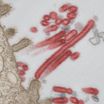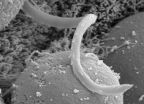(Press-News.org) Hurricanes Katrina and Rita may have been responsible for up to half of all recorded stillbirths in the worst hit areas, suggests research published online in the Journal of Epidemiology & Community Health.
And the true fetal death toll may even be higher, because of the displacement of people whose homes and way of life were destroyed, suggest the authors.
Hurricane Katrina struck the state of Louisiana, USA, on August 29 2005, followed by Hurricane Rita a month later on September 24. Katrina was the costliest natural disaster in American history, while Rita was the fourth most intense hurricane ever recorded.
Both hurricanes caused widespread damage to property and infrastructure and left a trail of injury, death, and trauma in their wake.
The researchers used composite figures from several government agencies, showing that the hurricanes caused damage in 38 out of 64 areas (parishes) in the state, with almost 205, 000 housing units affected.
In four parishes, more than half of the local housing stock was damaged; in three others, between 10% and 50% was damaged. Elsewhere, the level of damage to housing stock was categorised as 1%-10%, or less than 1%.
The researchers then calculated the odds of a pregnancy resulting in a stillbirth in damaged and undamaged areas (less than 1% damage) in the 20 months before, and the 28 months after, Katrina struck.
But they also looked at all birth data between 1999 and 2009 in Louisiana to gauge usual patterns: during this period, 5194 stillbirths were recorded.
They then used space-time models to assess whether the extent of damage wrought by the hurricanes was linked to the risk of stillbirths in a given area.
Their calculations indicated that the risk of a pregnancy ending in a stillbirth was 40% higher in parishes where 10-50% of housing stock had been damaged, and more than twice as high in areas where over 50% of the housing stock had taken a hit.
After taking account of known risk factors, every 1% increase in the extent of damage to housing stock was associated with a corresponding 7% rise in the number of stillbirths.
Based on these figures, the researchers calculated that of the 410 stillbirths officially recorded in extensively damaged parishes, up to half (117-205) may have been directly caused by the hurricanes and the subsequent devastation.
Their estimates suggest that stillbirths made up around 17.5% to 30.5% of the total death toll in the wake of the hurricanes.
But the risk of stillbirth may have been even higher, suggest the researchers. In the hardest hit areas, the number of live births was more than 40% lower in 2007 than it was in 2004. And in parishes with more half of the housing stock damaged, the live birth rate fell by 79% in the three months following Katrina.
This "precipitous decline" is likely to reflect the well documented exodus of residents from the coastal parishes of Louisiana into other areas, they suggest.
They point to previously published research, showing a link between maternal stress, depression, and trauma and birth complications, including stillbirths.
And they warn that climate change scientists have predicted an increase in the frequency, intensity, and duration of North Atlantic tropical cyclones like Hurricanes Katrina and Rita.
"Insofar as our empirical findings meaningfully generalise in time, the health risks to the unborn and their perinatal development will likely increase with more frequent and intense hurricanes," they write.
INFORMATION: [Maternal exposure to hurricane destruction and fetal mortality Online First doi 10.1136/jech-2014-203807]
Hurricanes Katrina and Rita may have caused up to half of recorded stillbirths in worst hit areas
Death toll may be higher because of exodus of displaced persons to other locales
2014-05-09
ELSE PRESS RELEASES FROM THIS DATE:
Super-charged tropical trees of Borneo vitally important for global carbon cycling
2014-05-09
A team of scientists has found that the woody growth of forests in north Borneo is half as great again as in the most productive forests of north-west Amazonia, an average difference of 3.2 tons of wood per hectare per year.
The new study, published today in the Journal of Ecology, examined differences in above-ground wood production (one component of the total uptake of carbon by plants) which is critically important in the global cycling of carbon.
Trees are taller for a given diameter in Southeast Asia compared with South America, meaning they gain more biomass ...
Exact outline of melanoma could lead to new diagnostic tools, therapies
2014-05-09
CORVALLIS, Ore. – Researchers at Oregon State University have identified a specific biochemical process that can cause normal and healthy skin cells to transform into cancerous melanoma cells, which should help predict melanoma vulnerability and could also lead to future therapies.
More than 70,000 cases of melanoma, the deadliest form of skin cancer, develop in the U.S. every year.
The work was published today in PLoS Genetics, in work supported by the National Institutes of Health.
"We believe this is a breakthrough in understanding exactly what leads to cancer ...
IL-27 balances the immune response to influenza and reduces lung damage
2014-05-09
Highly pathogenic (dangerous) influenza strains elicit a strong immune response which can lead to uncontrolled inflammation in the lung and potentially fatal lung injury. A study published on May 8th in PLOS Pathogens demonstrates the importance of IL-27 for the control of immunopathology—damage to the lung tissue caused by the immune system—and the therapeutic potential of well-timed IL-27 application to treat life-threatening inflammation during lung infection.
Alf Hamann, from Deutsches Rheuma-Forschungszentrum and Charité Universitätsmedizin Berlin, Germany, and colleagues, ...
SOCS4 prevents a cytokine storm and helps to clear influenza virus from the lung
2014-05-09
Certain influenza strains are highly virulent—they cause more serious disease and kill more people. Some of the damage is caused by the stronger immune response such strains elicit, especially in the lung. A study published on May 8th in PLOS Pathogens identifies SOCS4 as a key regulator of the immune response against influenza virus.
Lukasz Kedzierski, Sandra Nicholson, and colleagues from the Walter and Eliza Hall Institute of Medical Research and the University of Melbourne, Australia, studied mice with a mutation in the Socs4 gene, a member of a gene family whose ...
An extra doctor visit may help prevent rehospitalization of kidney failure patients
2014-05-09
Washington, DC (May 8, 2014) — More frequent face-to-face physician visits in the month following hospital discharge may help reduce a kidney failure patient's chances of needing to be sent back to the hospital. That's the conclusion of a study appearing in an upcoming issue of the Journal of the American Society of Nephrology (JASN). The study also found that closer outpatient monitoring of kidney failure patients following hospital discharge could cut health care costs significantly.
A major goal of health policy reform has been to reduce hospital readmissions within ...
Neurovance's EB-1020 SR for adult ADHD shows stimulant-like efficacy in Phase 2a trial
2014-05-09
Neurovance, Inc. today announced complete results from its phase 2a pilot study of EB-1020 SR, a non-stimulant, in adult male patients with all subtypes of ADHD (attention deficit hyperactivity disorder). EB-1020 SR is a norepinephrine- and dopamine-preferring triple reuptake inhibitor. The data showed a statistically significant improvement in ADHD symptoms on the ADHD-Rating Scale-IV (ADHD-RS-IV), the primary outcome measure, in a range similar to that reported in previously published trials with stimulants. EB-1020 SR appears to be well tolerated at the doses studied. ...
Ending the perfect storm: Protein key to beating flu pandemics
2014-05-09
VIDEO:
A protein called SOCS4 has been shown to act as a handbrake on the immune system's runaway reaction to flu infection, providing a possible means of minimising the impact of...
Click here for more information.
A protein called SOCS4 has been shown to act as a handbrake on the immune system's runaway reaction to flu infection, providing a possible means of minimising the impact of flu pandemics.
Scientists from Melbourne's Walter and Eliza Hall Institute have found that ...
Lethal parasite evolved from pond scum
2014-05-09
A genomic investigation by University of British Columbia researchers has revealed that a lethal parasite infecting a wide range of insects actually originated from pond scum, but has completely shed its green past on its evolutionary journey.
A team led by UBC Botany Prof. Patrick Keeling sequenced the genome of Helicosporidium – an intracellular parasite that can kill juvenile blackflies, caterpillars, beetles and mosquitoes – and found it evolved from algae like another notorious pathogen: malaria.
Keeling and colleagues had previously reported that malaria shared ...
Eating more fruits, vegetables may cut stroke risk worldwide
2014-05-08
Eating more fruits and vegetables may reduce the risk of stroke worldwide, according to new research in the American Heart Association's journal Stroke.
Researchers conducted a meta-analysis of 20 studies published over the last 19 years to assess the effects of fruit and vegetable consumption on risk of stroke globally. The combined studies involved 760,629 men and women who had 16,981 strokes.
Stroke risk decreased by 32 percent with every 200 grams of fruit consumed each day and 11 percent with every 200 grams of vegetables consumed each day.
"Improving diet and lifestyle ...
Common test used on heart patients who need defibrillator implants unnecessary: Study
2014-05-08
Hamilton, ON (May 8, 2014) – New research from McMaster University suggests that a commonly performed test during certain types of heart surgery is not helpful and possibly harmful.
The testing procedure, known as defibrillator testing (DT), is commonly used on people who require implantable cardioverter-defibrillators (ICDs) to prevent sudden cardiac death. It involves putting the patient into cardiac arrest to determine if the defibrillator can first recognize, then successfully shock the patient back into a normal heart rhythm. It requires the use of general anesthesia ...
LAST 30 PRESS RELEASES:
Low daily alcohol intake linked to 50% heightened mouth cancer risk in India
American Meteorological Society announces Rick Spinrad as 2026 President-Elect
Biomass-based carbon capture spotlighted in newly released global climate webinar recording
Illuminating invisible nano pollutants: advanced bioimaging tracks the full journey of emerging nanoscale contaminants in living systems
How does age affect recovery from spinal cord injury?
Novel AI tool offers prognosis for patients with head and neck cancer
Fathers’ microplastic exposure tied to their children’s metabolic problems
Research validates laboratory model for studying high-grade serous ovarian cancer
SIR 2026 delivers transformative breakthroughs in minimally invasive medicine to improve patient care
Stem Cell Reports most downloaded papers of 2025 highlight the breadth and impact of stem cell research
Oxford-led study estimates NHS spends around 3% of its primary and secondary care budget on the health impacts of heat and cold in England
A researcher’s long quest leads to a smart composite breakthrough
Urban wild bees act as “microbial sensors” of city health.
New study finds where you live affects recovery after a hip fracture
Forecasting the impact of fully automated vehicle adoption on US road traffic injuries
Alcohol-related hospitalizations from 2016 to 2022
Semaglutide and hospitalizations in patients with obesity and established cardiovascular disease
Researchers ‘listen in’ to embryo-mother interactions during implantation using a culture system replicating the womb lining
How changing your diet could help save the world
How to make AI truly scalable and reliable for real-time traffic assignment?
Beyond fragmented markets: A new framework for efficient and stable ride-pooling
Can shape priors make road perception more reliable for autonomous driving?
AI tracks nearly 100 years of aging research, revealing key trends and gaps
Innovative techniques enable Italy’s first imaging of individual trapped atoms
KIER successfully develops Korea-made “calibration thermoelectric module” for measuring thermoelectric device performance
Diversifying US Midwest farming for stability and resilience
Emphasizing immigrants’ deservingness shifts attitudes
Japanese eels, climate change, and river temperature
Pusan National University researchers discover faster, smarter heat treatment for lightweight magnesium metals
China’s 2024 Gastroenterology Report: marked progress in endoscopy quality and disease management
[Press-News.org] Hurricanes Katrina and Rita may have caused up to half of recorded stillbirths in worst hit areasDeath toll may be higher because of exodus of displaced persons to other locales




